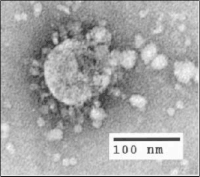
Photo from wikipedia
Objectives This study compares the infectivity of SARS-CoV-2 in respiratory samples from patients with mild COVID-19 with those from hospitalised patients with severe bilateral pneumonia. In severe COVID-19, we also… Click to show full abstract
Objectives This study compares the infectivity of SARS-CoV-2 in respiratory samples from patients with mild COVID-19 with those from hospitalised patients with severe bilateral pneumonia. In severe COVID-19, we also analysed the presence of neutralising activity in paired sera. Methods We performed cell cultures on 193 real-time reverse transcription polymerase chain reaction respiratory samples, positive for SARS-CoV-2, obtained from 189 patients at various times, from clinical diagnosis to follow-up. Eleven samples were obtained from asymptomatic individuals, 91 samples from 91 outpatients with mild forms of COVID-19, and 91 samples from 87 inpatients with severe pneumonia. In these patients, neutralising activity was analysed in 30 paired sera collected after symptom onset >10 days. Results We detected a cytopathic effect (CPE) in 91 (91/193, 47%) samples. Viral viability was maintained for up to 10 days in the patients with mild COVID-19. In the patients with severe COVID-19, the virus remained viable for up to 32 days after the onset of symptoms. Patients with severe COVID-19 presented infectious virus at a significantly higher rate in the samples with moderate to low viral load (cycle threshold value >26): 32/75 (43%) versus 14/63 (22%) for mild cases (P < 0.01). We observed a positive CPE despite the presence of clear neutralising activity (NT50 >1:1024 in 10% (3/30) of samples. Conclusions Patients with severe COVID-19 might shed viable virus during prolonged periods of up to 4 weeks after symptom onset, even when presenting high cycle threshold values in their respiratory samples and despite having developed high neutralising antibody titres.
Journal Title: Clinical Microbiology and Infection
Year Published: 2021
Link to full text (if available)
Share on Social Media: Sign Up to like & get
recommendations!